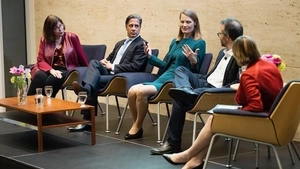Have you ever watched young children at play? They design and redesign sandcastles, towers, bridges, and forts. They build them, and knock them down.
The more Christine Cunningham has watched children interact with the world around them, the more she is convinced that they are natural engineers.
But when Cunningham, a Professor of Practice Professor of Practice in Education and Engineering at Penn State, began to investigate how engineering could be taught to elementary students, she saw that few schools were supporting those natural inclinations. Instead, she saw instruction that was educating engineering tendencies out of children. Cunningham went on to found Engineering is Elementary, and wrote Engineering in Elementary STEM Education. In 2017, her pioneering work in the field earned Cunningham the Harold W. McGraw, Jr. Prize in Education.
In February, the McGraw Prize announced its new home at Penn GSE. A week later, Cunningham kicked off a series of free webinars that will be hosted by past McGraw winners with a conversation about how elementary schools can incorporate engineering lessons, and why they should.
Here are seven key takeaways from Cunningham’s webinar, which you can watch in full here.
Why I do this work
From earliest memory I wanted to be a teacher. I distinctly remember when I started to ask the questions that guide my work. I was in 8th grade walking home from school with a friend. She stated that she didn’t want to do well in science anymore. I found this perplexing and tried to understand why. My questions led me to understand that her stance was due both to how the subject was taught and to the social peer pressures she was facing about being female and doing well in science.
This got me thinking deeply about what needed to change about how science is taught and learned. How can we change science teaching so it’s more interesting and relevant? Who is welcomed? What talent and perspectives are driven away or never invited to participate? I decided to focus on how I could make science education more relevant, accessible, and inclusive to all students.
Why teach engineering in elementary school?
We spend 98% of our time interacting with the human-made, or engineered, world: For example, we use toothpaste, bicycles, bandages, buildings, and smartphones. But school traditionally only had included study of the natural world through science. This does not reflect the world we live in. I decided I wanted to change this.
When I proposed doing engineering with elementary-aged students, many people thought I was a little crazy. In part because they could not envision what it looked like. I got comments like, “You’re going to do calculus with second graders?” Well, children don’t read James Joyce in second grade, but they certainly can develop literary practices and foundations. I knew we could do the same for engineering.
Narrative matters
Research shows children, particularly girls and students from underrepresented groups, are more interested and motivated when they connect their learning to the real-world. Using narratives and role models can help children see how engineers help people, animals, society, and the environment. Roles models, particularly those that students can connect with, also help draw students in. Such context-setting elements should differ by age and setting.
We’ve found different ways of connecting with learners of different ages.
Preschoolers might have a “conversation” with an engineering puppet. The friendly puppet signals preschoolers that it is engineering time. The puppet asks for students’ help to make a simple technology to solve a problem. By the way, pilot testing taught us that they need to be friendly and not have scary teeth. The alligator puppet produced some distress!
At the elementary level, we introduced engineering challenges using illustrated storybooks that feature a child somewhere in the world who encounters a problem that she or he solves using engineering. We carefully create characters from all over the world, who have different appearances, abilities and disabilities, family structures, and hobbies.
Videos of real engineers in their workplace or news articles that describe existing problems similar to those middle or high school students are tackling can help students understand why the work they do is relevant and meaningful. The contexts can be furthered strengthened by connecting the challenge to students’ own lives.
So does scaffolding
One of the first things I did when I started to work at the elementary level was to convene a group of experts—elementary classroom teachers—for guidance about how to communicate the engineering design process at the elementary level. They strongly insisted that an age-appropriate process could include no more than one hand of steps – five – or their students would not remember it.
So we developed a process with 5 phases—Ask, Imagine, Plan, Create, and Improve. As we moved into middle school, children can developmentally manage more phases—so middle school processes often have 8 phases. And when we looked to teach engineering to preschoolers, we distilled the essence of the process to 3 phases—Explore, Create, Improve. Regardless of the number of phases in the engineering design process, the named guideposts help communicate the organizing frame and purpose for that day’s activity to all students and scaffold them through problem solving.
There is always a second solution. Or a third.
Open-ended challenges with multiple possible solutions can re-engage students, giving them the opportunity to think creatively. After all, in the real world, engineering problems rarely have one unique solution—the solution usually depends on the context. We carefully design engineering problems so they invite multiple solutions.
The challenges articulate criteria and constraints and students evaluate the merit of their solutions with respect to these. Along the way, we encourage students to take risks and review their classmates’ ideas and solutions as well. The opportunity to think creatively and design something truly unique makes engineering highly interesting and engaging for students.
Failure is not a failure
Not all students’ solutions work the first time. Embracing failure can be a new experience for students. But failure is a necessary and inherent part of engineering (and life). When a design fails it isn’t “wrong”—failure is an opportunity for engineers to improve their design. Learning that failure is valuable can be liberating for students, especially students who have been low achievers on traditional academic measures.
Improvement is a process
As we design engineering activities, we consider how they can invite students to think about engineering as an iterative event, present failure as an unavoidable step, and require that solutions be redesigned as least once. Engineering design processes have an “Improve” or “Iterate” step built in help communicate these messages. Students know, right from the beginning, that they will try and try again—that engineering involves multiple iterations.

Subscribe to the Educator's Playbook
Get the latest release of the Educator's Playbook delivered straight to your inbox.
Media Inquiries
Penn GSE Communications is here to help reporters connect with the education experts they need.









